Corporation Act 2001: Strategies for Managing Legal Risks Effectively
VerifiedAdded on 2023/06/11
|18
|5062
|260
Report
AI Summary
This report provides a comprehensive analysis of managing legal risks within organizations under the Corporation Act 2001 (Cth). It begins by outlining the background and rationale of the Act, highlighting its importance in governing corporate operations and preventing fraudulent activities. The report identifies key legal, management, and relationship issues shaped by the legislation, including the duties of directors and protection of stakeholders. It discusses the application of the legislation to organizations, emphasizing obligations related to public funding, directors' responsibilities, and corporate governance. A significant focus is placed on high legal risk areas, particularly directors' duties, exploring reasons and implications in both short and long terms. Strategies for managing legal risks are presented, along with their associated costs and benefits. The report concludes with recommendations for effective risk management, emphasizing the importance of compliance to ensure ethical and legal corporate functioning. Desklib offers a range of study tools, including solved assignments and past papers, to aid students in understanding and applying these concepts.
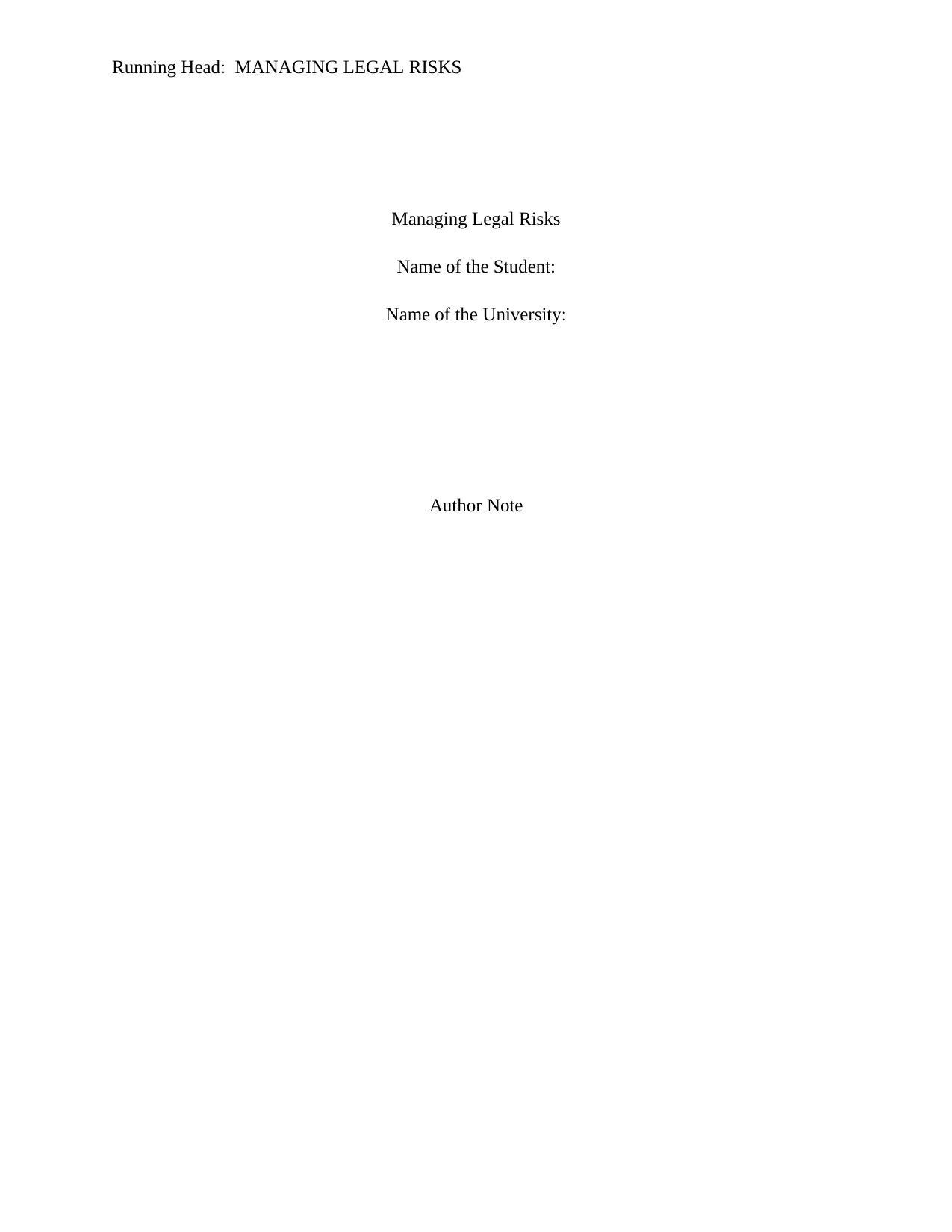
Running Head: MANAGING LEGAL RISKS
Managing Legal Risks
Name of the Student:
Name of the University:
Author Note
Managing Legal Risks
Name of the Student:
Name of the University:
Author Note
Paraphrase This Document
Need a fresh take? Get an instant paraphrase of this document with our AI Paraphraser
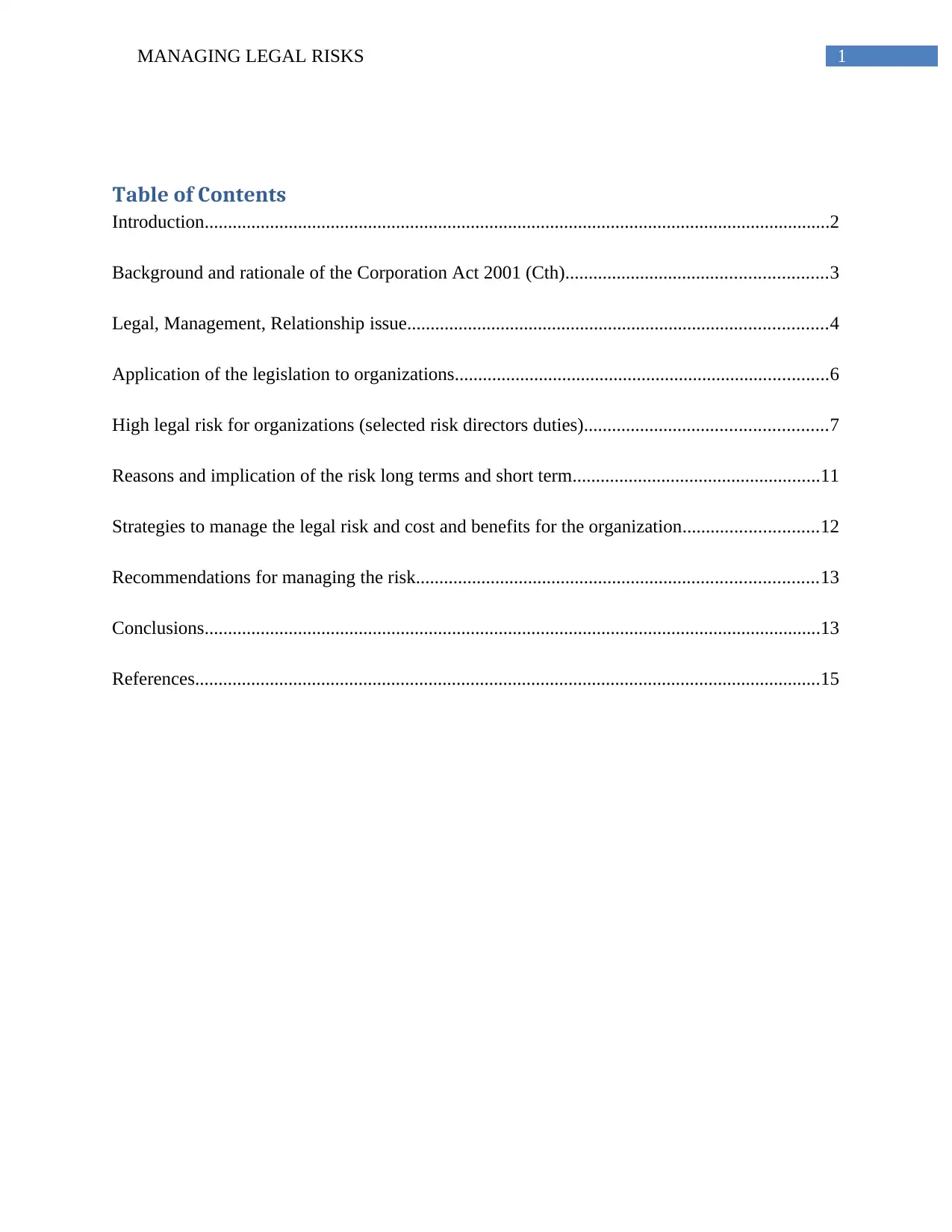
1MANAGING LEGAL RISKS
Table of Contents
Introduction......................................................................................................................................2
Background and rationale of the Corporation Act 2001 (Cth)........................................................3
Legal, Management, Relationship issue..........................................................................................4
Application of the legislation to organizations................................................................................6
High legal risk for organizations (selected risk directors duties)....................................................7
Reasons and implication of the risk long terms and short term.....................................................11
Strategies to manage the legal risk and cost and benefits for the organization.............................12
Recommendations for managing the risk......................................................................................13
Conclusions....................................................................................................................................13
References......................................................................................................................................15
Table of Contents
Introduction......................................................................................................................................2
Background and rationale of the Corporation Act 2001 (Cth)........................................................3
Legal, Management, Relationship issue..........................................................................................4
Application of the legislation to organizations................................................................................6
High legal risk for organizations (selected risk directors duties)....................................................7
Reasons and implication of the risk long terms and short term.....................................................11
Strategies to manage the legal risk and cost and benefits for the organization.............................12
Recommendations for managing the risk......................................................................................13
Conclusions....................................................................................................................................13
References......................................................................................................................................15
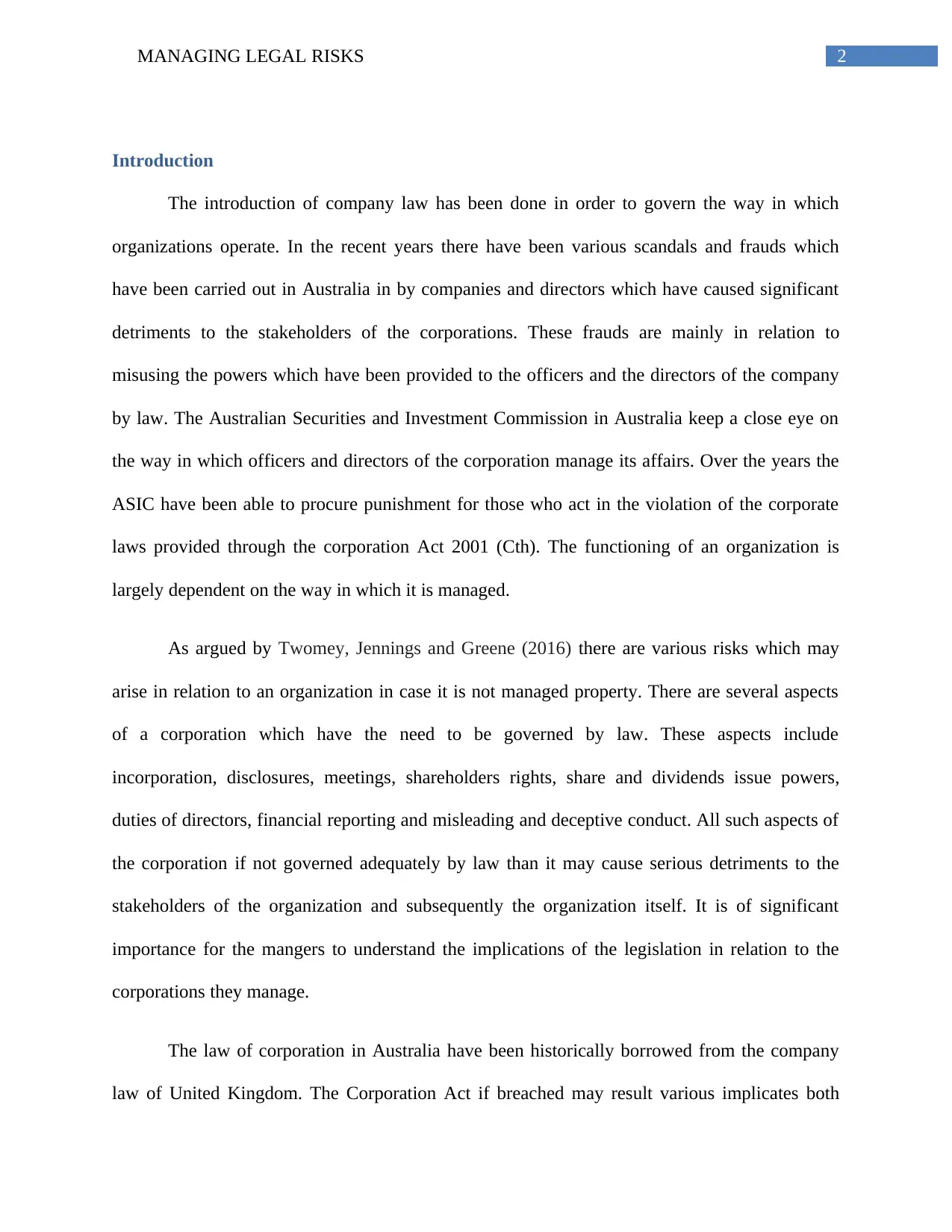
2MANAGING LEGAL RISKS
Introduction
The introduction of company law has been done in order to govern the way in which
organizations operate. In the recent years there have been various scandals and frauds which
have been carried out in Australia in by companies and directors which have caused significant
detriments to the stakeholders of the corporations. These frauds are mainly in relation to
misusing the powers which have been provided to the officers and the directors of the company
by law. The Australian Securities and Investment Commission in Australia keep a close eye on
the way in which officers and directors of the corporation manage its affairs. Over the years the
ASIC have been able to procure punishment for those who act in the violation of the corporate
laws provided through the corporation Act 2001 (Cth). The functioning of an organization is
largely dependent on the way in which it is managed.
As argued by Twomey, Jennings and Greene (2016) there are various risks which may
arise in relation to an organization in case it is not managed property. There are several aspects
of a corporation which have the need to be governed by law. These aspects include
incorporation, disclosures, meetings, shareholders rights, share and dividends issue powers,
duties of directors, financial reporting and misleading and deceptive conduct. All such aspects of
the corporation if not governed adequately by law than it may cause serious detriments to the
stakeholders of the organization and subsequently the organization itself. It is of significant
importance for the mangers to understand the implications of the legislation in relation to the
corporations they manage.
The law of corporation in Australia have been historically borrowed from the company
law of United Kingdom. The Corporation Act if breached may result various implicates both
Introduction
The introduction of company law has been done in order to govern the way in which
organizations operate. In the recent years there have been various scandals and frauds which
have been carried out in Australia in by companies and directors which have caused significant
detriments to the stakeholders of the corporations. These frauds are mainly in relation to
misusing the powers which have been provided to the officers and the directors of the company
by law. The Australian Securities and Investment Commission in Australia keep a close eye on
the way in which officers and directors of the corporation manage its affairs. Over the years the
ASIC have been able to procure punishment for those who act in the violation of the corporate
laws provided through the corporation Act 2001 (Cth). The functioning of an organization is
largely dependent on the way in which it is managed.
As argued by Twomey, Jennings and Greene (2016) there are various risks which may
arise in relation to an organization in case it is not managed property. There are several aspects
of a corporation which have the need to be governed by law. These aspects include
incorporation, disclosures, meetings, shareholders rights, share and dividends issue powers,
duties of directors, financial reporting and misleading and deceptive conduct. All such aspects of
the corporation if not governed adequately by law than it may cause serious detriments to the
stakeholders of the organization and subsequently the organization itself. It is of significant
importance for the mangers to understand the implications of the legislation in relation to the
corporations they manage.
The law of corporation in Australia have been historically borrowed from the company
law of United Kingdom. The Corporation Act if breached may result various implicates both
⊘ This is a preview!⊘
Do you want full access?
Subscribe today to unlock all pages.

Trusted by 1+ million students worldwide
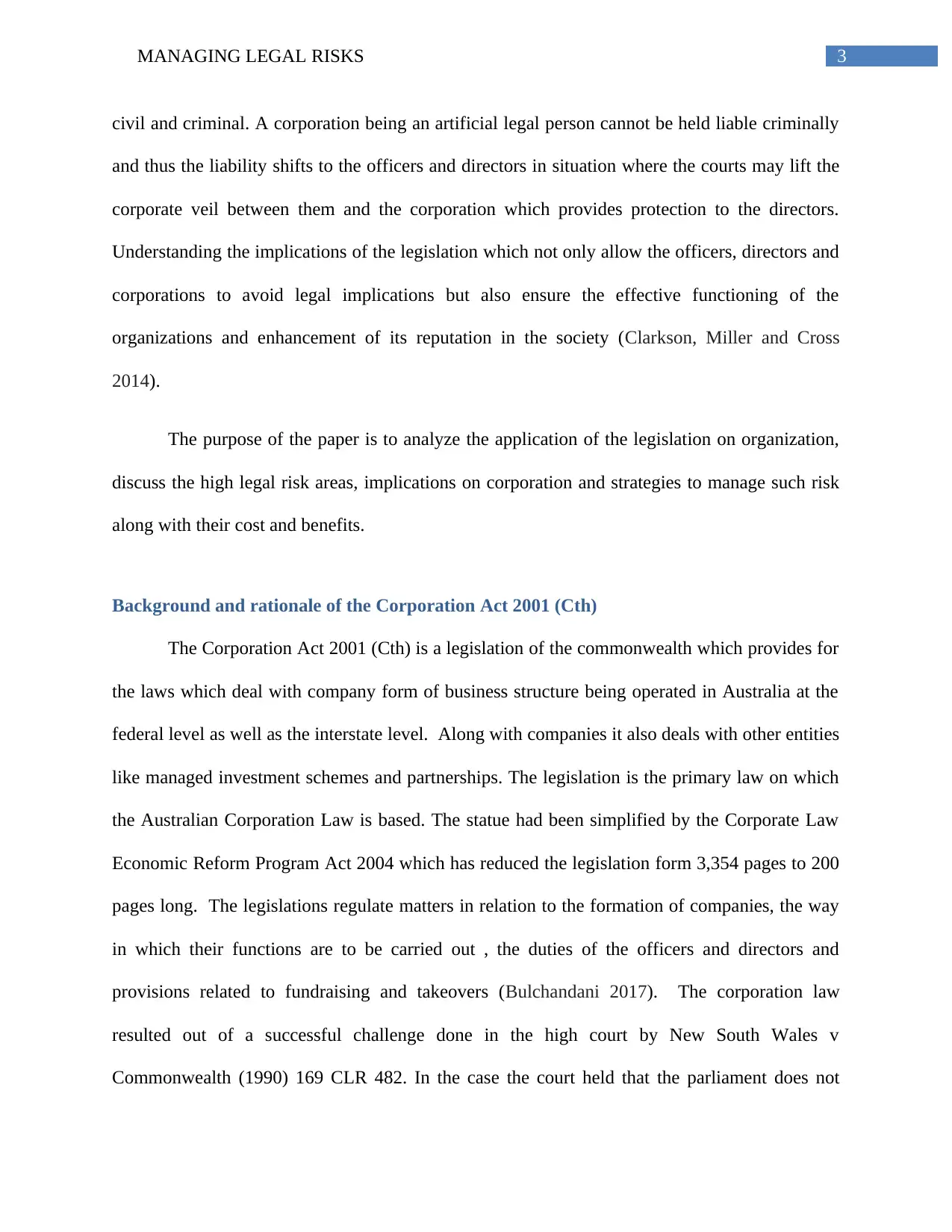
3MANAGING LEGAL RISKS
civil and criminal. A corporation being an artificial legal person cannot be held liable criminally
and thus the liability shifts to the officers and directors in situation where the courts may lift the
corporate veil between them and the corporation which provides protection to the directors.
Understanding the implications of the legislation which not only allow the officers, directors and
corporations to avoid legal implications but also ensure the effective functioning of the
organizations and enhancement of its reputation in the society (Clarkson, Miller and Cross
2014).
The purpose of the paper is to analyze the application of the legislation on organization,
discuss the high legal risk areas, implications on corporation and strategies to manage such risk
along with their cost and benefits.
Background and rationale of the Corporation Act 2001 (Cth)
The Corporation Act 2001 (Cth) is a legislation of the commonwealth which provides for
the laws which deal with company form of business structure being operated in Australia at the
federal level as well as the interstate level. Along with companies it also deals with other entities
like managed investment schemes and partnerships. The legislation is the primary law on which
the Australian Corporation Law is based. The statue had been simplified by the Corporate Law
Economic Reform Program Act 2004 which has reduced the legislation form 3,354 pages to 200
pages long. The legislations regulate matters in relation to the formation of companies, the way
in which their functions are to be carried out , the duties of the officers and directors and
provisions related to fundraising and takeovers (Bulchandani 2017). The corporation law
resulted out of a successful challenge done in the high court by New South Wales v
Commonwealth (1990) 169 CLR 482. In the case the court held that the parliament does not
civil and criminal. A corporation being an artificial legal person cannot be held liable criminally
and thus the liability shifts to the officers and directors in situation where the courts may lift the
corporate veil between them and the corporation which provides protection to the directors.
Understanding the implications of the legislation which not only allow the officers, directors and
corporations to avoid legal implications but also ensure the effective functioning of the
organizations and enhancement of its reputation in the society (Clarkson, Miller and Cross
2014).
The purpose of the paper is to analyze the application of the legislation on organization,
discuss the high legal risk areas, implications on corporation and strategies to manage such risk
along with their cost and benefits.
Background and rationale of the Corporation Act 2001 (Cth)
The Corporation Act 2001 (Cth) is a legislation of the commonwealth which provides for
the laws which deal with company form of business structure being operated in Australia at the
federal level as well as the interstate level. Along with companies it also deals with other entities
like managed investment schemes and partnerships. The legislation is the primary law on which
the Australian Corporation Law is based. The statue had been simplified by the Corporate Law
Economic Reform Program Act 2004 which has reduced the legislation form 3,354 pages to 200
pages long. The legislations regulate matters in relation to the formation of companies, the way
in which their functions are to be carried out , the duties of the officers and directors and
provisions related to fundraising and takeovers (Bulchandani 2017). The corporation law
resulted out of a successful challenge done in the high court by New South Wales v
Commonwealth (1990) 169 CLR 482. In the case the court held that the parliament does not
Paraphrase This Document
Need a fresh take? Get an instant paraphrase of this document with our AI Paraphraser
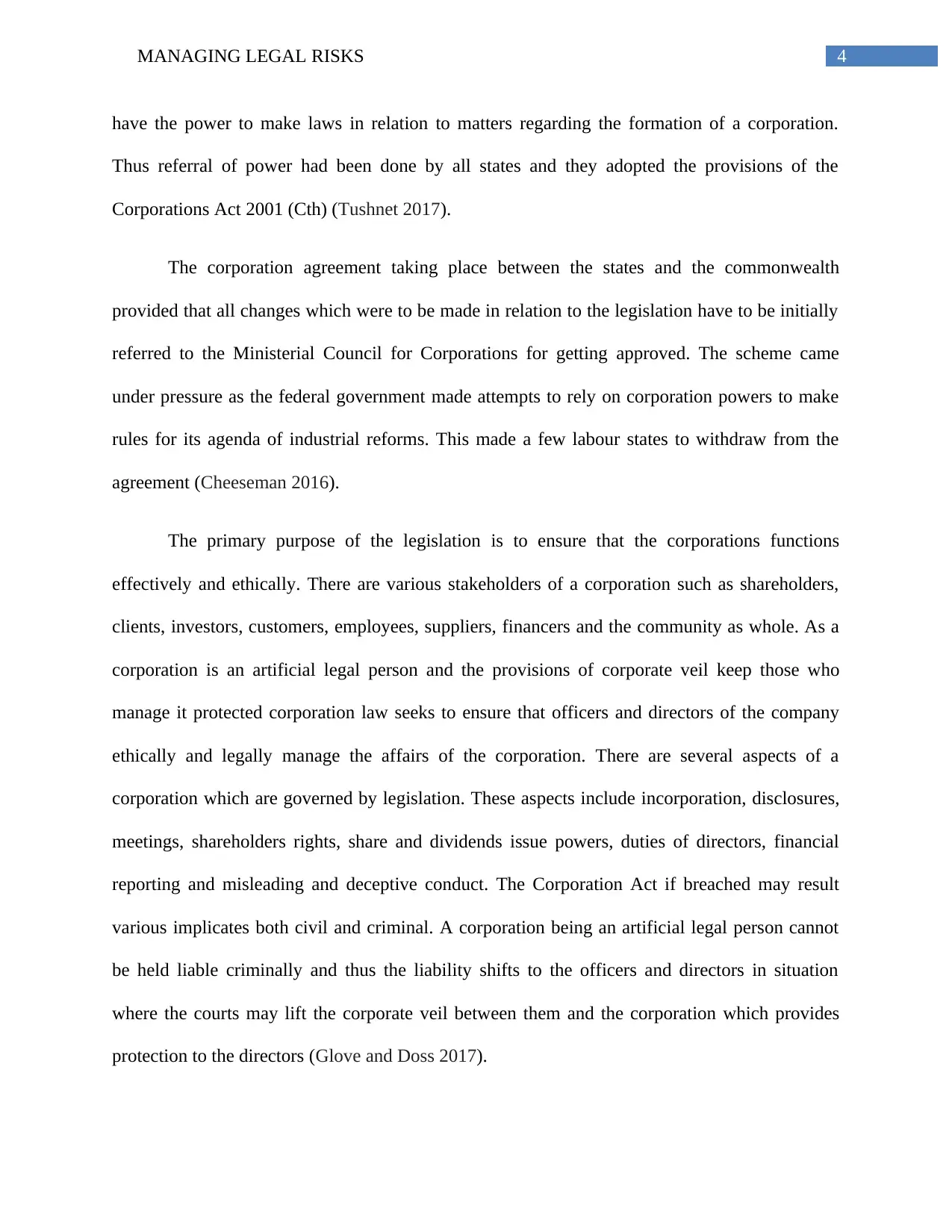
4MANAGING LEGAL RISKS
have the power to make laws in relation to matters regarding the formation of a corporation.
Thus referral of power had been done by all states and they adopted the provisions of the
Corporations Act 2001 (Cth) (Tushnet 2017).
The corporation agreement taking place between the states and the commonwealth
provided that all changes which were to be made in relation to the legislation have to be initially
referred to the Ministerial Council for Corporations for getting approved. The scheme came
under pressure as the federal government made attempts to rely on corporation powers to make
rules for its agenda of industrial reforms. This made a few labour states to withdraw from the
agreement (Cheeseman 2016).
The primary purpose of the legislation is to ensure that the corporations functions
effectively and ethically. There are various stakeholders of a corporation such as shareholders,
clients, investors, customers, employees, suppliers, financers and the community as whole. As a
corporation is an artificial legal person and the provisions of corporate veil keep those who
manage it protected corporation law seeks to ensure that officers and directors of the company
ethically and legally manage the affairs of the corporation. There are several aspects of a
corporation which are governed by legislation. These aspects include incorporation, disclosures,
meetings, shareholders rights, share and dividends issue powers, duties of directors, financial
reporting and misleading and deceptive conduct. The Corporation Act if breached may result
various implicates both civil and criminal. A corporation being an artificial legal person cannot
be held liable criminally and thus the liability shifts to the officers and directors in situation
where the courts may lift the corporate veil between them and the corporation which provides
protection to the directors (Glove and Doss 2017).
have the power to make laws in relation to matters regarding the formation of a corporation.
Thus referral of power had been done by all states and they adopted the provisions of the
Corporations Act 2001 (Cth) (Tushnet 2017).
The corporation agreement taking place between the states and the commonwealth
provided that all changes which were to be made in relation to the legislation have to be initially
referred to the Ministerial Council for Corporations for getting approved. The scheme came
under pressure as the federal government made attempts to rely on corporation powers to make
rules for its agenda of industrial reforms. This made a few labour states to withdraw from the
agreement (Cheeseman 2016).
The primary purpose of the legislation is to ensure that the corporations functions
effectively and ethically. There are various stakeholders of a corporation such as shareholders,
clients, investors, customers, employees, suppliers, financers and the community as whole. As a
corporation is an artificial legal person and the provisions of corporate veil keep those who
manage it protected corporation law seeks to ensure that officers and directors of the company
ethically and legally manage the affairs of the corporation. There are several aspects of a
corporation which are governed by legislation. These aspects include incorporation, disclosures,
meetings, shareholders rights, share and dividends issue powers, duties of directors, financial
reporting and misleading and deceptive conduct. The Corporation Act if breached may result
various implicates both civil and criminal. A corporation being an artificial legal person cannot
be held liable criminally and thus the liability shifts to the officers and directors in situation
where the courts may lift the corporate veil between them and the corporation which provides
protection to the directors (Glove and Doss 2017).

5MANAGING LEGAL RISKS
Legal, Management, Relationship issue
There are several legal, management and relationship issue which arise in relation to an
organization and are addressed via the provisions of the legislations. The legislation along with
the corporate governance principles laid down by the Australian Securities exchange provide for
the way in which an organization is to be managed. The ASX corporate governance principles
are mere guidelines. However even where they do not have to be followed by the company
mandatorily any organization who dies not wish to o implement these principles have to do it on
an “if not why not” basis. This means that they needs to provide an explanation to the ASX that
if they do not select the organization to be managed by the ASX recommended principles than
what is the reason behind non acceptance of the principles. The legislation governs the legal
relationship between the states and the corporation (Allen and Kraakman 2016). The managerial
relationship between the corporation and the directors and also the general relationships between
the stakeholders of the company with the company itself are all governed by the legislation. The
legal issue which are shaped by the legislation includes whether the legislation allows or the
incorporation of a company or not. The allowance depends upon the facts that the company is
formed for a proper purpose. The other legal issue which are shaped by the legislations are in
relation to whether the directors and officers are complying with their duties or not.
They have a fiduciary obligation towards the company which means that their actions
should always be directed towards pursuing the interest of the company rather than any form of
personal interest of any interest belonging to a third party. Being the fiduciaries of the company
it is also an duty of the directors to disclose any relevant facts which an organization must known
as the directors or officers are able to make personal profits by making use of the position and
information n the organization. The legislation also shapes the issues which may arise out of the
Legal, Management, Relationship issue
There are several legal, management and relationship issue which arise in relation to an
organization and are addressed via the provisions of the legislations. The legislation along with
the corporate governance principles laid down by the Australian Securities exchange provide for
the way in which an organization is to be managed. The ASX corporate governance principles
are mere guidelines. However even where they do not have to be followed by the company
mandatorily any organization who dies not wish to o implement these principles have to do it on
an “if not why not” basis. This means that they needs to provide an explanation to the ASX that
if they do not select the organization to be managed by the ASX recommended principles than
what is the reason behind non acceptance of the principles. The legislation governs the legal
relationship between the states and the corporation (Allen and Kraakman 2016). The managerial
relationship between the corporation and the directors and also the general relationships between
the stakeholders of the company with the company itself are all governed by the legislation. The
legal issue which are shaped by the legislation includes whether the legislation allows or the
incorporation of a company or not. The allowance depends upon the facts that the company is
formed for a proper purpose. The other legal issue which are shaped by the legislations are in
relation to whether the directors and officers are complying with their duties or not.
They have a fiduciary obligation towards the company which means that their actions
should always be directed towards pursuing the interest of the company rather than any form of
personal interest of any interest belonging to a third party. Being the fiduciaries of the company
it is also an duty of the directors to disclose any relevant facts which an organization must known
as the directors or officers are able to make personal profits by making use of the position and
information n the organization. The legislation also shapes the issues which may arise out of the
⊘ This is a preview!⊘
Do you want full access?
Subscribe today to unlock all pages.

Trusted by 1+ million students worldwide
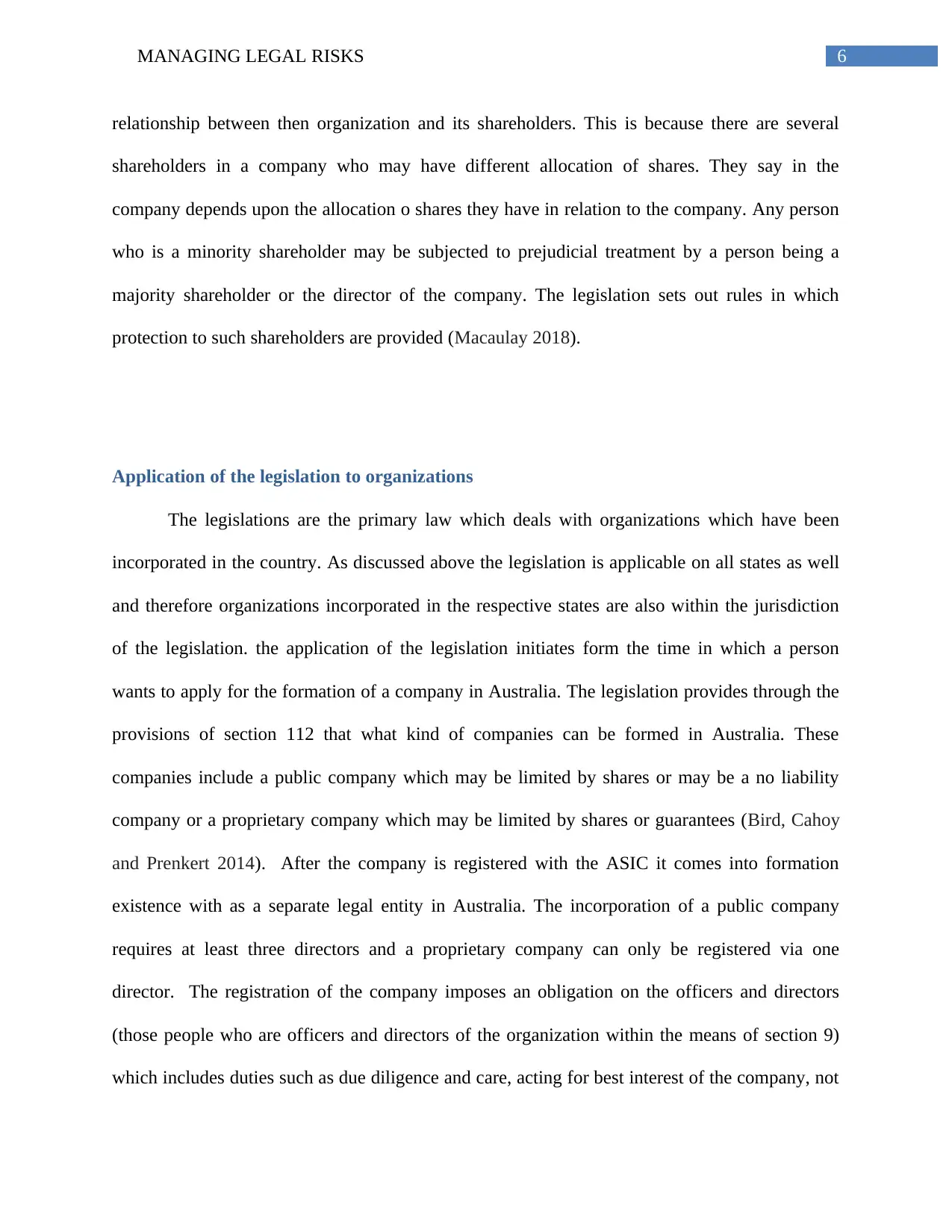
6MANAGING LEGAL RISKS
relationship between then organization and its shareholders. This is because there are several
shareholders in a company who may have different allocation of shares. They say in the
company depends upon the allocation o shares they have in relation to the company. Any person
who is a minority shareholder may be subjected to prejudicial treatment by a person being a
majority shareholder or the director of the company. The legislation sets out rules in which
protection to such shareholders are provided (Macaulay 2018).
Application of the legislation to organizations
The legislations are the primary law which deals with organizations which have been
incorporated in the country. As discussed above the legislation is applicable on all states as well
and therefore organizations incorporated in the respective states are also within the jurisdiction
of the legislation. the application of the legislation initiates form the time in which a person
wants to apply for the formation of a company in Australia. The legislation provides through the
provisions of section 112 that what kind of companies can be formed in Australia. These
companies include a public company which may be limited by shares or may be a no liability
company or a proprietary company which may be limited by shares or guarantees (Bird, Cahoy
and Prenkert 2014). After the company is registered with the ASIC it comes into formation
existence with as a separate legal entity in Australia. The incorporation of a public company
requires at least three directors and a proprietary company can only be registered via one
director. The registration of the company imposes an obligation on the officers and directors
(those people who are officers and directors of the organization within the means of section 9)
which includes duties such as due diligence and care, acting for best interest of the company, not
relationship between then organization and its shareholders. This is because there are several
shareholders in a company who may have different allocation of shares. They say in the
company depends upon the allocation o shares they have in relation to the company. Any person
who is a minority shareholder may be subjected to prejudicial treatment by a person being a
majority shareholder or the director of the company. The legislation sets out rules in which
protection to such shareholders are provided (Macaulay 2018).
Application of the legislation to organizations
The legislations are the primary law which deals with organizations which have been
incorporated in the country. As discussed above the legislation is applicable on all states as well
and therefore organizations incorporated in the respective states are also within the jurisdiction
of the legislation. the application of the legislation initiates form the time in which a person
wants to apply for the formation of a company in Australia. The legislation provides through the
provisions of section 112 that what kind of companies can be formed in Australia. These
companies include a public company which may be limited by shares or may be a no liability
company or a proprietary company which may be limited by shares or guarantees (Bird, Cahoy
and Prenkert 2014). After the company is registered with the ASIC it comes into formation
existence with as a separate legal entity in Australia. The incorporation of a public company
requires at least three directors and a proprietary company can only be registered via one
director. The registration of the company imposes an obligation on the officers and directors
(those people who are officers and directors of the organization within the means of section 9)
which includes duties such as due diligence and care, acting for best interest of the company, not
Paraphrase This Document
Need a fresh take? Get an instant paraphrase of this document with our AI Paraphraser
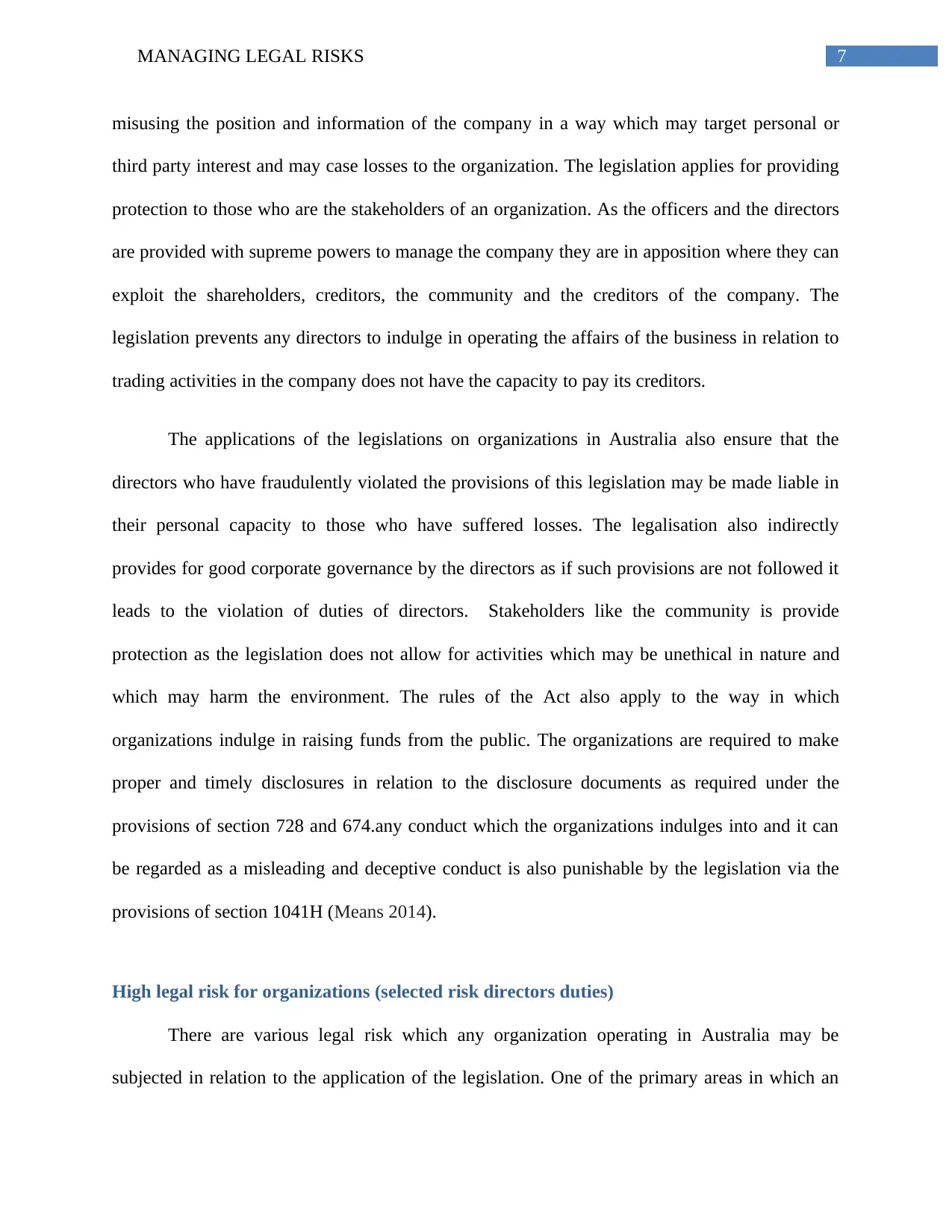
7MANAGING LEGAL RISKS
misusing the position and information of the company in a way which may target personal or
third party interest and may case losses to the organization. The legislation applies for providing
protection to those who are the stakeholders of an organization. As the officers and the directors
are provided with supreme powers to manage the company they are in apposition where they can
exploit the shareholders, creditors, the community and the creditors of the company. The
legislation prevents any directors to indulge in operating the affairs of the business in relation to
trading activities in the company does not have the capacity to pay its creditors.
The applications of the legislations on organizations in Australia also ensure that the
directors who have fraudulently violated the provisions of this legislation may be made liable in
their personal capacity to those who have suffered losses. The legalisation also indirectly
provides for good corporate governance by the directors as if such provisions are not followed it
leads to the violation of duties of directors. Stakeholders like the community is provide
protection as the legislation does not allow for activities which may be unethical in nature and
which may harm the environment. The rules of the Act also apply to the way in which
organizations indulge in raising funds from the public. The organizations are required to make
proper and timely disclosures in relation to the disclosure documents as required under the
provisions of section 728 and 674.any conduct which the organizations indulges into and it can
be regarded as a misleading and deceptive conduct is also punishable by the legislation via the
provisions of section 1041H (Means 2014).
High legal risk for organizations (selected risk directors duties)
There are various legal risk which any organization operating in Australia may be
subjected in relation to the application of the legislation. One of the primary areas in which an
misusing the position and information of the company in a way which may target personal or
third party interest and may case losses to the organization. The legislation applies for providing
protection to those who are the stakeholders of an organization. As the officers and the directors
are provided with supreme powers to manage the company they are in apposition where they can
exploit the shareholders, creditors, the community and the creditors of the company. The
legislation prevents any directors to indulge in operating the affairs of the business in relation to
trading activities in the company does not have the capacity to pay its creditors.
The applications of the legislations on organizations in Australia also ensure that the
directors who have fraudulently violated the provisions of this legislation may be made liable in
their personal capacity to those who have suffered losses. The legalisation also indirectly
provides for good corporate governance by the directors as if such provisions are not followed it
leads to the violation of duties of directors. Stakeholders like the community is provide
protection as the legislation does not allow for activities which may be unethical in nature and
which may harm the environment. The rules of the Act also apply to the way in which
organizations indulge in raising funds from the public. The organizations are required to make
proper and timely disclosures in relation to the disclosure documents as required under the
provisions of section 728 and 674.any conduct which the organizations indulges into and it can
be regarded as a misleading and deceptive conduct is also punishable by the legislation via the
provisions of section 1041H (Means 2014).
High legal risk for organizations (selected risk directors duties)
There are various legal risk which any organization operating in Australia may be
subjected in relation to the application of the legislation. One of the primary areas in which an

8MANAGING LEGAL RISKS
organization indulges in is that of rising public funding. Any organization which is registered
with the ASX has the rights to rise funding from the public in order to increase its capital. When
an organization wants to raise funds there are several legal provisions provided by the legislation
which they need to comply with. These provisions are in relation to the contents of the offer
document which is also known as a prospectus document. The prospectus document requires
both general and specific disclosure under the provisions of section 708 and 710 of the Act
(Morgan, 2015). It provides that such documents must contain all information which may be
revenant for a person who wants to invest in the shares. The prospectus document must contain
all correct are relevant information. Any misstatement in relation to the document may lead to
the breach of section 728 of the Legislation which would not only make the organization liable
for the breach but also any person who has made the organization breach such provisions of law.
In addition under the rules of section 674 any information which a reasonable shareholder will
feel to have affected the share price of the company would also have to be disclosed
continuously to the ASX and the failure to do so will result in the breach of this section for the
organization as well any person who has made the organization to violate the legal principles.
One of the primary examples of this situation had been seen in the case of Australian Securities
and Investment Commission v Sino Oil and Gas Limited. In this case the director who had
difficulties in understanding English along with the company had been held liable for the breach
of section 728 and 674 of the legislation. in another case of ASIC v Fortescue Metals Group Ltd
(2011) 190 in this case although the directors were no held liable for the breach of directors
duties they were held liable in relation breach of disclosure obligations and the provisions of
misstatement in prospectus (Frank and Bix 2017).
organization indulges in is that of rising public funding. Any organization which is registered
with the ASX has the rights to rise funding from the public in order to increase its capital. When
an organization wants to raise funds there are several legal provisions provided by the legislation
which they need to comply with. These provisions are in relation to the contents of the offer
document which is also known as a prospectus document. The prospectus document requires
both general and specific disclosure under the provisions of section 708 and 710 of the Act
(Morgan, 2015). It provides that such documents must contain all information which may be
revenant for a person who wants to invest in the shares. The prospectus document must contain
all correct are relevant information. Any misstatement in relation to the document may lead to
the breach of section 728 of the Legislation which would not only make the organization liable
for the breach but also any person who has made the organization breach such provisions of law.
In addition under the rules of section 674 any information which a reasonable shareholder will
feel to have affected the share price of the company would also have to be disclosed
continuously to the ASX and the failure to do so will result in the breach of this section for the
organization as well any person who has made the organization to violate the legal principles.
One of the primary examples of this situation had been seen in the case of Australian Securities
and Investment Commission v Sino Oil and Gas Limited. In this case the director who had
difficulties in understanding English along with the company had been held liable for the breach
of section 728 and 674 of the legislation. in another case of ASIC v Fortescue Metals Group Ltd
(2011) 190 in this case although the directors were no held liable for the breach of directors
duties they were held liable in relation breach of disclosure obligations and the provisions of
misstatement in prospectus (Frank and Bix 2017).
⊘ This is a preview!⊘
Do you want full access?
Subscribe today to unlock all pages.

Trusted by 1+ million students worldwide

9MANAGING LEGAL RISKS
Another area of legal risk which is present in relation to the legislations is that related to
the way in which a meetings of an organization needs to be carried out. Any organization which
is operating in Australia have the obligation of carrying out periodic meetings where plans and
performance of the company needs to be discussed. The failure to carry out the meetings as
asked under the provisions of section 349 of the Act would lead to the contravention of the
legislation by the company and any person who was indulged in making the company violate
such provisions. Risk may also be posed to the organization if they it has acted in a way which is
derogatory to its minority shareholders. The court may order the organization to compensate the
minority shareholders in case their interest has been wrongly dealt with. The capital maintenance
doctrine is also made a part of the legislation through the provisions of section 254. The
organization is not allowed to indulge into actions through which it would take into consideration
reducing the share capital of the company in to the detriment of its shareholders. The
organizations may also be subjected to the risk related to the breach of section 1041H of the
Legislation if their actions in relation to a financial product such as securities are those which are
misleading or deceptive or those which are likely to mislead of deceive (McAdams et al. 2015).
The focus of this section would however be on one of the areas of the legislation which
pose the highest risks to the organizations and is one of the most litigated areas of the legislation.
This area is that of the duties of directors and others officers of a company. One of the key
functions of the management is in relation to business decision making and such decisions can
make the directors and officers of the organization fall into trouble if they are not been taken in a
way which a reasonable officer or director in the same position would take. One of such
examples had been seen in the case of Australian Securities and Investments Commission
(ASIC) v Cassimatis (No. 8) [2016] FCA 1023 (Scarborough 2015). In this case the directors of
Another area of legal risk which is present in relation to the legislations is that related to
the way in which a meetings of an organization needs to be carried out. Any organization which
is operating in Australia have the obligation of carrying out periodic meetings where plans and
performance of the company needs to be discussed. The failure to carry out the meetings as
asked under the provisions of section 349 of the Act would lead to the contravention of the
legislation by the company and any person who was indulged in making the company violate
such provisions. Risk may also be posed to the organization if they it has acted in a way which is
derogatory to its minority shareholders. The court may order the organization to compensate the
minority shareholders in case their interest has been wrongly dealt with. The capital maintenance
doctrine is also made a part of the legislation through the provisions of section 254. The
organization is not allowed to indulge into actions through which it would take into consideration
reducing the share capital of the company in to the detriment of its shareholders. The
organizations may also be subjected to the risk related to the breach of section 1041H of the
Legislation if their actions in relation to a financial product such as securities are those which are
misleading or deceptive or those which are likely to mislead of deceive (McAdams et al. 2015).
The focus of this section would however be on one of the areas of the legislation which
pose the highest risks to the organizations and is one of the most litigated areas of the legislation.
This area is that of the duties of directors and others officers of a company. One of the key
functions of the management is in relation to business decision making and such decisions can
make the directors and officers of the organization fall into trouble if they are not been taken in a
way which a reasonable officer or director in the same position would take. One of such
examples had been seen in the case of Australian Securities and Investments Commission
(ASIC) v Cassimatis (No. 8) [2016] FCA 1023 (Scarborough 2015). In this case the directors of
Paraphrase This Document
Need a fresh take? Get an instant paraphrase of this document with our AI Paraphraser
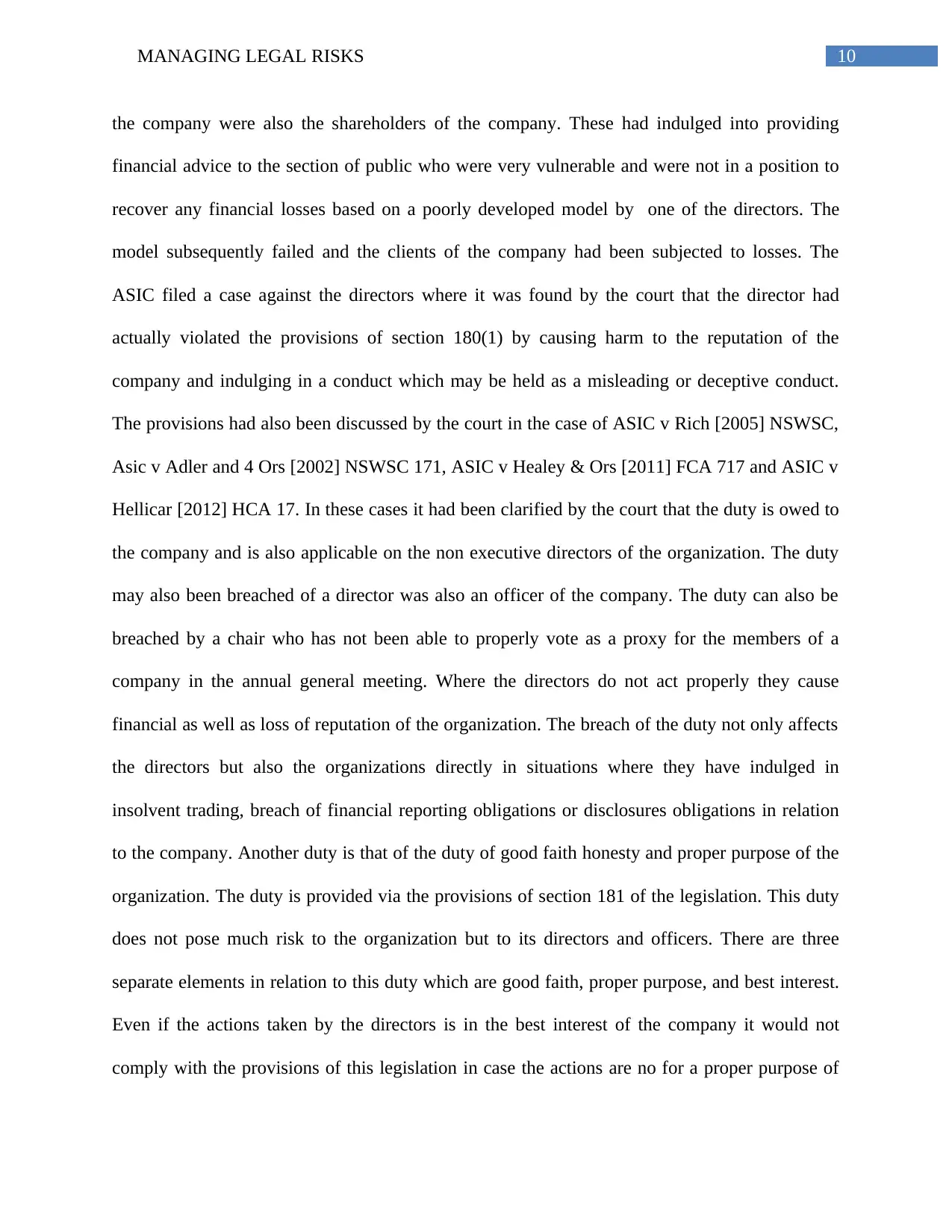
10MANAGING LEGAL RISKS
the company were also the shareholders of the company. These had indulged into providing
financial advice to the section of public who were very vulnerable and were not in a position to
recover any financial losses based on a poorly developed model by one of the directors. The
model subsequently failed and the clients of the company had been subjected to losses. The
ASIC filed a case against the directors where it was found by the court that the director had
actually violated the provisions of section 180(1) by causing harm to the reputation of the
company and indulging in a conduct which may be held as a misleading or deceptive conduct.
The provisions had also been discussed by the court in the case of ASIC v Rich [2005] NSWSC,
Asic v Adler and 4 Ors [2002] NSWSC 171, ASIC v Healey & Ors [2011] FCA 717 and ASIC v
Hellicar [2012] HCA 17. In these cases it had been clarified by the court that the duty is owed to
the company and is also applicable on the non executive directors of the organization. The duty
may also been breached of a director was also an officer of the company. The duty can also be
breached by a chair who has not been able to properly vote as a proxy for the members of a
company in the annual general meeting. Where the directors do not act properly they cause
financial as well as loss of reputation of the organization. The breach of the duty not only affects
the directors but also the organizations directly in situations where they have indulged in
insolvent trading, breach of financial reporting obligations or disclosures obligations in relation
to the company. Another duty is that of the duty of good faith honesty and proper purpose of the
organization. The duty is provided via the provisions of section 181 of the legislation. This duty
does not pose much risk to the organization but to its directors and officers. There are three
separate elements in relation to this duty which are good faith, proper purpose, and best interest.
Even if the actions taken by the directors is in the best interest of the company it would not
comply with the provisions of this legislation in case the actions are no for a proper purpose of
the company were also the shareholders of the company. These had indulged into providing
financial advice to the section of public who were very vulnerable and were not in a position to
recover any financial losses based on a poorly developed model by one of the directors. The
model subsequently failed and the clients of the company had been subjected to losses. The
ASIC filed a case against the directors where it was found by the court that the director had
actually violated the provisions of section 180(1) by causing harm to the reputation of the
company and indulging in a conduct which may be held as a misleading or deceptive conduct.
The provisions had also been discussed by the court in the case of ASIC v Rich [2005] NSWSC,
Asic v Adler and 4 Ors [2002] NSWSC 171, ASIC v Healey & Ors [2011] FCA 717 and ASIC v
Hellicar [2012] HCA 17. In these cases it had been clarified by the court that the duty is owed to
the company and is also applicable on the non executive directors of the organization. The duty
may also been breached of a director was also an officer of the company. The duty can also be
breached by a chair who has not been able to properly vote as a proxy for the members of a
company in the annual general meeting. Where the directors do not act properly they cause
financial as well as loss of reputation of the organization. The breach of the duty not only affects
the directors but also the organizations directly in situations where they have indulged in
insolvent trading, breach of financial reporting obligations or disclosures obligations in relation
to the company. Another duty is that of the duty of good faith honesty and proper purpose of the
organization. The duty is provided via the provisions of section 181 of the legislation. This duty
does not pose much risk to the organization but to its directors and officers. There are three
separate elements in relation to this duty which are good faith, proper purpose, and best interest.
Even if the actions taken by the directors is in the best interest of the company it would not
comply with the provisions of this legislation in case the actions are no for a proper purpose of
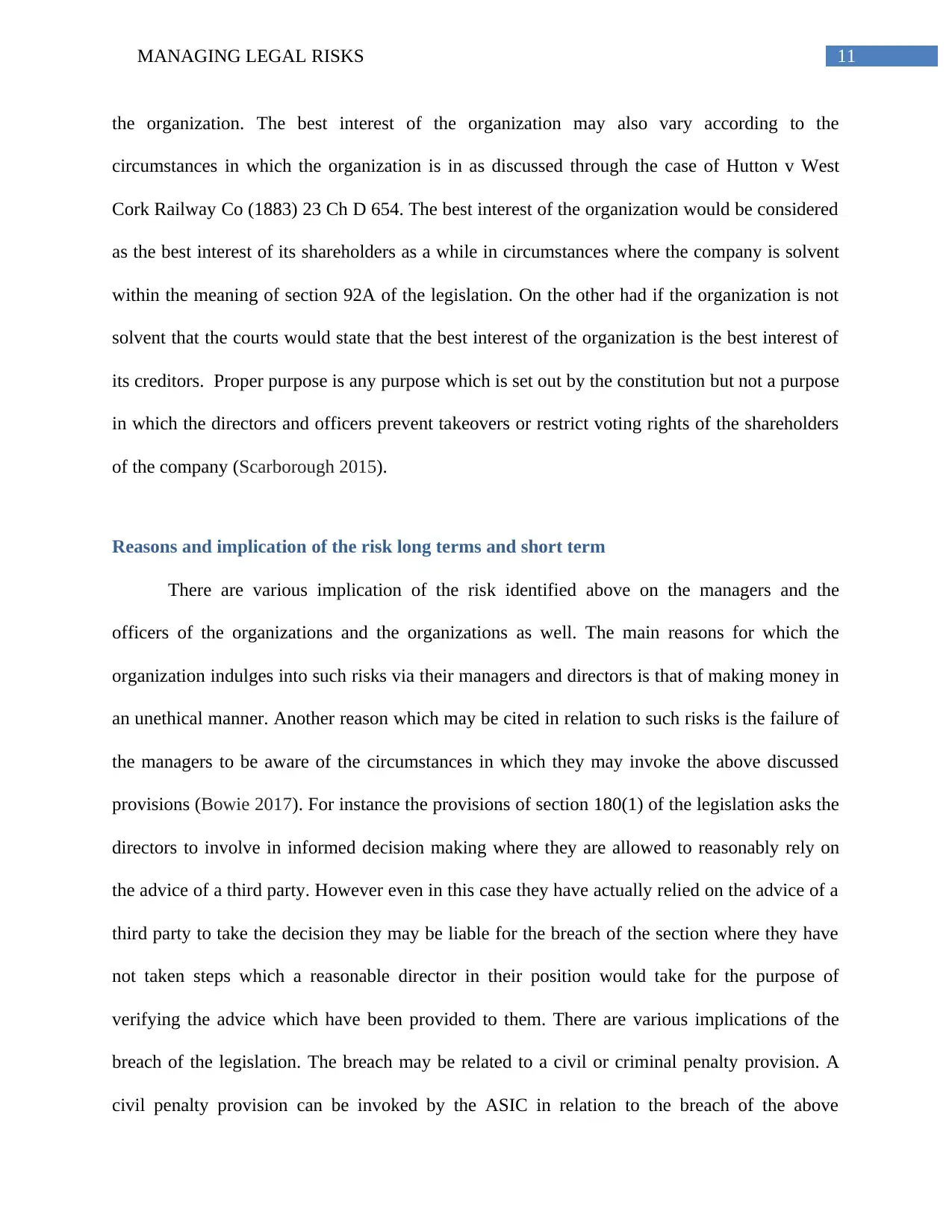
11MANAGING LEGAL RISKS
the organization. The best interest of the organization may also vary according to the
circumstances in which the organization is in as discussed through the case of Hutton v West
Cork Railway Co (1883) 23 Ch D 654. The best interest of the organization would be considered
as the best interest of its shareholders as a while in circumstances where the company is solvent
within the meaning of section 92A of the legislation. On the other had if the organization is not
solvent that the courts would state that the best interest of the organization is the best interest of
its creditors. Proper purpose is any purpose which is set out by the constitution but not a purpose
in which the directors and officers prevent takeovers or restrict voting rights of the shareholders
of the company (Scarborough 2015).
Reasons and implication of the risk long terms and short term
There are various implication of the risk identified above on the managers and the
officers of the organizations and the organizations as well. The main reasons for which the
organization indulges into such risks via their managers and directors is that of making money in
an unethical manner. Another reason which may be cited in relation to such risks is the failure of
the managers to be aware of the circumstances in which they may invoke the above discussed
provisions (Bowie 2017). For instance the provisions of section 180(1) of the legislation asks the
directors to involve in informed decision making where they are allowed to reasonably rely on
the advice of a third party. However even in this case they have actually relied on the advice of a
third party to take the decision they may be liable for the breach of the section where they have
not taken steps which a reasonable director in their position would take for the purpose of
verifying the advice which have been provided to them. There are various implications of the
breach of the legislation. The breach may be related to a civil or criminal penalty provision. A
civil penalty provision can be invoked by the ASIC in relation to the breach of the above
the organization. The best interest of the organization may also vary according to the
circumstances in which the organization is in as discussed through the case of Hutton v West
Cork Railway Co (1883) 23 Ch D 654. The best interest of the organization would be considered
as the best interest of its shareholders as a while in circumstances where the company is solvent
within the meaning of section 92A of the legislation. On the other had if the organization is not
solvent that the courts would state that the best interest of the organization is the best interest of
its creditors. Proper purpose is any purpose which is set out by the constitution but not a purpose
in which the directors and officers prevent takeovers or restrict voting rights of the shareholders
of the company (Scarborough 2015).
Reasons and implication of the risk long terms and short term
There are various implication of the risk identified above on the managers and the
officers of the organizations and the organizations as well. The main reasons for which the
organization indulges into such risks via their managers and directors is that of making money in
an unethical manner. Another reason which may be cited in relation to such risks is the failure of
the managers to be aware of the circumstances in which they may invoke the above discussed
provisions (Bowie 2017). For instance the provisions of section 180(1) of the legislation asks the
directors to involve in informed decision making where they are allowed to reasonably rely on
the advice of a third party. However even in this case they have actually relied on the advice of a
third party to take the decision they may be liable for the breach of the section where they have
not taken steps which a reasonable director in their position would take for the purpose of
verifying the advice which have been provided to them. There are various implications of the
breach of the legislation. The breach may be related to a civil or criminal penalty provision. A
civil penalty provision can be invoked by the ASIC in relation to the breach of the above
⊘ This is a preview!⊘
Do you want full access?
Subscribe today to unlock all pages.

Trusted by 1+ million students worldwide
1 out of 18
Related Documents
Your All-in-One AI-Powered Toolkit for Academic Success.
+13062052269
info@desklib.com
Available 24*7 on WhatsApp / Email
![[object Object]](/_next/static/media/star-bottom.7253800d.svg)
Unlock your academic potential
Copyright © 2020–2025 A2Z Services. All Rights Reserved. Developed and managed by ZUCOL.





